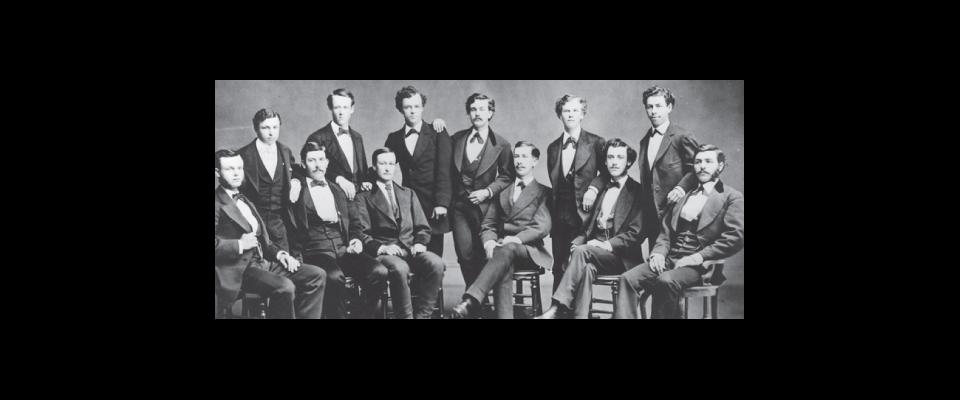A tradition of support for the University.
On July 16, 1872, 11 of the 12 members of Cal’s first graduating class—known to history as “The Twelve Apostles”—met at Brayton Hall in downtown Oakland with a handful of graduates of the old College of California to found the University Alumni Association.
Their purpose, as stated in the new organization’s constitution, was “the promotion of good fellowship and kindly feeling among its members and the fostering of liberal and scientific culture on the Pacific Coast.”
Since then, the Cal Alumni Association has grown to represent more than 100,000 members, remained the only independent UC alumni association, expanded its offerings, and changed its name a few times. It also formally adopted as its core mission to advance and promote the welfare of the University.
Of course, that’s something CAA has been doing all along. As early as the 1890s, when legislators in Sacramento balked at increasing the University’s funding to keep up with skyrocketing enrollment, the Association successfully organized alumni around the state to lobby for a law, signed by Gov. James Budd ’73, that doubled funding.
In 1915 the Association flexed its muscles again, convincing voters to approve the state’s first higher education building bond proposal—an achievement that has been repeated many times since, most notably in 1956, when passage of a massive construction bond measure earned CAA a national award from the American Alumni Council. When America entered WW I in 1917 the Alumni Association opened the Military Bureau on campus, with files of faculty and alumni with skills critical to the war effort. After the war the Military Bureau morphed into the Employment Bureau—the precursor of the Campus Career Center.
“The prevailing belief was that the University provided the education but the rest of it was not the University’s problem,” says Peter Van Houten ’56, M.A. ’62, Ed.D. ’73. “So it was up to the alumni to step up.”
The University acknowledged the alumni’s rising importance in 1919 when CAA President Wigginton E. Creed ’98 was appointed an ex officio member of the Board of Regents. That practice continued until 1999, when the University decided on a new policy: Each association president would become a Regent immediately after finishing his term on the CAA board. This was to spare the current president from having to do two jobs at the same time.
In 1934 the statewide Alumni Scholarship Fund was launched by CAA’s longtime executive manager (now titled executive director), Robert Sibley ’03. In 1948 the Lair of the Golden Bear opened, followed six years later by Alumni House, thanks to the many thousands of alumni who donated funds for its construction.
Then came 1964—the year of the Free Speech Movement, an event that changed both the University and CAA forever. “President Kerr and Chancellor Martin Meyerson, who were trying to broker a compromise, came under fire not only from hardliners in the press, but also from the alumni council,” says Jim Kidder ’57, M.A. ’71, C. Phil. ’74, “which was a shock because the council was supposed to be there to support the University.”
So a group of young alums, dubbed the Mod Squad—led by Colette Murray (née Samuelsen) ’58 and including Kidder, Bob Hamilton ’56, Kathy Hamilton ’55, Ned Averbuck ’61, Dave Lowe ’58, J.D. ’61, Mike Savage ’56, M.A. ’59, and Roger Samuelsen ’58, J.D. ’64—demanded a stronger voice for younger alumni, starting with nominating one of their own, the late George Link ’61, for CAA president.
“George not only was elected, making him the youngest CAA president ever up to that point, but we also won most of the seats on the board,” says Kidder.
Another barrier fell in 1982, when Shirley Conner ’48 became the CAA’s first female president, but not without protests. Some said “it’s a man’s job and should always be held by a man,” Conner recalls.
“The best thing that happened was that Mike Heyman was selected as chancellor that year. He decided to visit as many alumni clubs around the country as possible, and he took me with him on all these trips. It sent a powerful message to the alumni.”
When Cal started admitting more minority students in the 1980s, CAA responded with the student outreach and mentoring programs.
The Scholarship Program, which began in 1934 by offering $180 grants to 13 students, now offers scholarships ranging from $2,000 to $6,000 per year to 770 students. The Equity Scholarship was set up in 2008 to reflect the University’s desire to attract qualified underrepresented minority students.
“When you think that we started with just 11 alumni, and now we have some 450,000 living throughout the world, it speaks to the excellence of this University,” says Karen Leong Clancy ’76, the current CAA president. “As alumni, we have an obligation to the new alumni and today’s undergraduates to pass on the traditions we love and build on them.”
To learn more about CAA’s history, visit alumni.berkeley.edu/140-years.




















